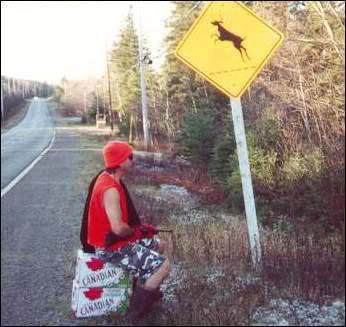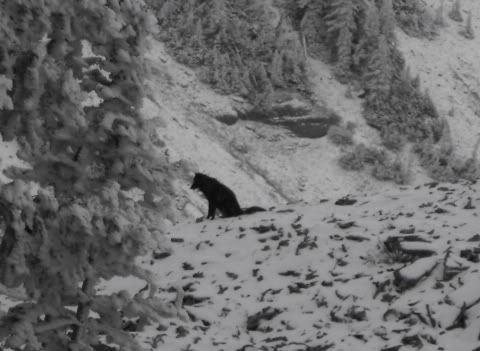The following story was emailed to me. I consider the source reliable and the pictures substantiate the story. What does this have to do with Mule Deer? I’ll let you figure that out. The author was apparently in Wyoming where wolves are having a hey day on game animals.
———————————–

I had one heck of an experience this past Friday. I was walking into an area I spotted 5 bulls last weekend when wolves started howling, growling and snarling about 300 yds away in the timber below me. It was just getting light so, I hung out for a while hoping to get a look at the wolves. Nothing appeared so, thinking that there were probably no elk in this spot, I headed back to the truck. I unloaded the ATV and was headed to an area called the “Natural Corral” on Bald Ridge.
About ½ mile down the dirt road I came upon a herd of cattle running around in a circle and making all sorts of sounds. The herd parted and 2 wolves popped out to look at me. Just beyond the two was another wolf on the hind end of a cow pulling a chunk of flesh from the cow that was still alive. The two wolves ran to my right and stopped about 50 yds away.
The wolf on the cow jumped off and stood on the road. I charged him with the ATV and he ran to my right and stopped 25 yds. away. I had my .44 mag and could have popped him, but knowing the penalty for killing a wolf, I pulled out the camera instead and took a picture of him while he was running away. It’s a grueling sight to see an animal being eaten alive.
I called 911 to get the local Game Warden, Chris Queen. He called back and was heading to the spot after he finished loading hay. I asked if I should put the cow down since it was still alive. He knew the owner of the herd and said not to finish it since the owner was particular about killing his cattle.
Chris called Mark Brucino, USF&W biologist that handles wolves and grizzlies in the area. Mark called me back to say he was on the way. I told him that I was heading back out to look for elk and would be back later.

The wolves starting to attack the herd again further down the road behind me. I took off down the road, but the wolves were gone. I got back to elk hunting and spotted 3 groups of cows, calves and spike bulls totaling 41. A plane appeared and was flying transect patterns. I knew it must be FWS people. The elk didn’t care for the plane and slowly head back into cover. This was not working for elk hunting so I twisted off the hunt and headed back to the truck. At the kill site I met Mark and an agent with USDA Wildlife Services (formerly Animal Damages Board), Monty Nicholson. Mark said they were trying to pick up any signals from collared wolves. None of the wolves I saw had collars. After explaining my account of the situation and a description of the wolves they made a decision to call in a chopper and hunt them down. The chopper came in and Monty jumped in with a 12 gauge and #4 Buckshot, his standard load for killing wolves and coyotes from a chopper.
Monty had explained that the area I was in is the border for 3 wolf packs; Sunlight Basin, Absaroka and Clark’s Fork. He believes these 3 wolves are lead by a older male wolf that walks with a limp. Because of the injury the older wolf cannot compete with stronger wolves for females and is leading the 3 younger males. The older wolf has a radio collar, however the plane did not pick up the signal.
Soon the rancher and trail riders arrived. Mark wrote out a ticket for the rancher to get reimbursed “7 to 1″ meaning he will get paid 7 times the cost of the 2 yr. old cow. It is based on the assumption that the cow would be able to produce 7 calves during the life span. Of course the money comes from the State even though the Feds brought the wolves into WY and now we have to deal with the mess.
What was the cost of this one situation?
– Time for 1 DOI FWS biologist
– Time for 1 USDA Wildlife Services agent
– Time for 1 WY Game Warden
– Flight time for 1 surveillance plane
– Flight time for 1 chopper
– Payment for 1 cow (.85/lb x 1000 lbs x 7 = $5,950)
So much for wolf management in WY. I could have helped out for the low, low price of one .44 mag round. At least I could have taken care of ¼ of the pack!
———————————-
Story submitted by Paul Baxter







